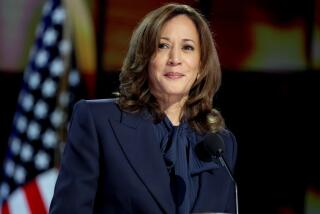Essential Politics: A tightened race and a lot of undecided voters
Democrats might have wished for Hillary Clinton’s big, post-convention lead to last right through election day, but that was never likely.
Instead, like almost all convention bounces — why else would we call them by that name? — Clinton’s came back down to earth. The result has the race pretty much back to where it was at the start of the summer, with one big difference.
Good afternoon, I’m David Lauter, Washington bureau chief. Welcome to the Friday edition of our Essential Politics newsletter, in which we look at the events of the week in the presidential campaign and highlight some particularly insightful stories.
GROUNDHOG DAY?
Go back to June 1, before FBI Director James B. Comey sharply criticized Clinton for her handling of classified information while secretary of State, before Clinton and Donald Trump named their running mates, before the two party conventions and millions of dollars of TV ads: Clinton led Trump by about 5 percentage points in polling averages.
That’s where the race stands once again and has all this past week.
So does that mean that the entire summer’s worth of campaigning — all those headlines, all that rushing around — went for naught?
No.
One thing has changed hugely: the clock.
On June 1, Trump had five months in which to find a way to catch up with Clinton. Now he has 59 days.
The Clinton campaign has used the past three months to try to close off routes that Trump might have been able to take. Several states, most notably Virginia and Colorado, now seem out of Trump’s reach. He trails in Pennsylvania, a key battleground, largely because of his problems with college-educated, suburban white voters, reports Cathy Decker.
That same dynamic has Democrats considering a serious effort to win Georgia, something they haven’t done since 1992, writes Mark Barabak. Bill Clinton, who was the last Democrat to carry the state, is a big advocate of making a renewed push there, which would require a major effort to register and turn out black voters.
But Trump still has potential advantages: After two terms of a Democrat in the White House, voters’ customary desire for change would normally make the Republican nominee at least a small favorite. He has rock-solid support from his core backers.
And, as I wrote earlier this week in an analysis of polling data, a lot of voters remain up for grabs.
The number of voters who remain undecided between the two major party candidates — about one in five — and the even larger number of people whose support for a chosen candidate remains soft mean that the race will remain up for grabs at least through the first presidential debate, scheduled for Sept. 26.
DON’T FORGET THE ELECTORAL COLLEGE
As our interactive electoral map shows, Clinton currently leads in more than enough states to secure the White House. But if the race tightens further, some of those states could begin to change.
Winning requires 270 electoral votes. How to get there? We’ve updated the map with our best estimates. Now you get to play political strategist and try out as many scenarios as you like.
FOLLOW OUR TRACKING POLL
The USC Dornsife/Los Angeles Times tracking poll has been tracing Trump’s and Clinton’s trajectories since early summer.
The poll shows a tighter race than many other surveys. Why is it different? Here are several of the reasons. and here’s what the poll tells us about Trump’s potential path forward.
WHAT ABOUT THIRD PARTIES?
With all those uncertain voters, and two major-party candidates who remain deeply unpopular, one might think that this year would provide a great opportunity for a third party.
So far, it’s an opportunity lost.
The Libertarian candidate, Gary Johnson, has been getting about 9% support in polls all summer. That’s well short of the 15% threshold for participating in the debates. And, unfortunately for Johnson, the fact that about a third of his backers are under 30 isn’t a good sign — young people are less reliable voters than their elders, particularly in the absence of a well-funded get-out-the-vote effort.
Thursday, Johnson hurt himself further by blanking out when asked in a televised interview about Aleppo, the Syrian city that’s been at the center of that country’s civil war and humanitarian crisis.
As Melanie Mason wrote, “What is Aleppo?” may become Johnson’s most memorable campaign line, much as retired Adm. James Stockdale, Ross Perot’s running mate, got tagged by his “Who am I? Why am I here?” remark in the 1992 vice presidential debate.
Another minor-party candidate, Jill Stein of the Green Party, has been receiving about 3% support in polls. That’s way better than her showing four years ago, where she got less than half a percent of the vote, but it’s also not having an impact on the overall results — at least so far. Stein also sat down with our Los Angeles Times editorial board this week to talk about why she thinks voting Democrat or Republican makes little difference.
THE CONTEST IS HEATING UP
The 2016 campaign has already been a brawl, but as the first debate nears, it’s becoming more intense. Clinton, who for a while seemed content to let Trump hog the spotlight, is no longer coasting, reports Evan Halper. The Democratic nominee has been repeatedly talking to reporters, whom she mostly kept at arm’s length during the spring and summer, and is aggressively trying to drive the campaign debate.
Clinton’s new approach comes about in part because her aides feel that they can’t count on debate moderators to challenge Trump’s statements. At Wednesday’s candidate forum on national security issues, for example, Trump repeated his claim to have opposed the war in Iraq from the beginning, which is clearly contradicted by his own statements at the time. The moderator, Matt Lauer, did not question him about the claim.
Lauer has been pummeled for his questioning, Stephen Battaglio reported.
Both sides are framing the race as a referendum on Trump, Decker reported from Ohio — Clinton because she sees that as a clearest path to victory, Trump because he can’t help himself.
Trump is starting to unfurl some policy positions, but many raise as many questions as they answer. Consider his plan to increase military spending, for example, which Noah Bierman and Bill Hennigan analyzed. The plan offers only faint outlines of how Trump would pay for his promises.
In another sign of an intensifying campaign, President Obama, who plans to stump for Clinton this coming week in Pennsylvania, stepped up his criticism of Trump, hitting his “outright wacky ideas,” Christi Parsons reported from Laos, where the president was meeting with Asian leaders.
A FEW GOOD READS
Remember this summer, when Gov. Chris Christie of New Jersey campaigned hard to be chosen as Trump’s running mate? Imagine how that would have played out. The Bridgegate trial is finally getting underway, reports Joe Tanfani, and much attention will be paid to any hints about what Christie knew of his aides’ plans to create traffic jams at the George Washington Bridge.
With the FBI and others talking about Russian cyberattacks on U.S. databases, there’s been a lot of speculation about an effort by Vladimir Putin to hack the U.S. election. The risk is seriously overstated, Del Wilber reports, largely because the U.S. election process is so decentralized — and so antiquated in most of its systems — that it’s not particularly vulnerable to online tampering.
The Obama administration is considering an end to putting immigrants in privately owned detention centers. But immigration officials are pushing back, reports Brian Bennett. Closing the private detention centers would be a major victory for civil rights and immigrant advocacy groups.
And Noam Levey takes a look at the latest problems with the Obamacare marketplaces and finds an interesting pattern: States with the biggest Obamacare problems are the ones that have actively tried to impede the law.
QUESTIONS ABOUT TRUMP, CLINTON? WE’VE GOT ANSWERS
Where they stand on issues, what they’ve done in their lives, their successes, their failures, what their presidencies might look like: We’ve been writing about Clinton and Trump for years, and we’ve pulled the best of that content together to make finding what you want to know easier. So check out All Things Trump and All Things Clinton.
LOGISTICS
If you like this newsletter, tell your friends to sign up.
That wraps up this week. My colleague Christina Bellantoni will be back Monday with the weekday edition of Essential Politics. Until then, keep track of all the developments in the 2016 campaign with our Trail Guide, at our Politics page and on Twitter @latimespolitics.
Send your comments, suggestions and news tips to politics@latimes.com.
More to Read
Get the L.A. Times Politics newsletter
Deeply reported insights into legislation, politics and policy from Sacramento, Washington and beyond. In your inbox three times per week.
You may occasionally receive promotional content from the Los Angeles Times.











